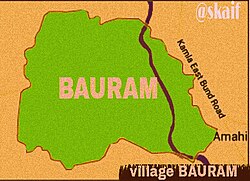Bauram
Bauram
بورام बौराम | |
|---|---|
village | |
 Map of village Bauram | |
| Coordinates: 25°58′26″N 86°19′11″E / 25.973910°N 86.319607°E | |
| Country | |
| State | Bihar |
| District | Darbhanga |
| Sub division | Biraul |
| Police station | Jamalpur |
| Outpost (O.P.) | Badgaaon |
| settled in | about 1600 A.D. |
| Government | |
| • Type | Gram panchayat |
| • Body | sarpanch |
| Area (approx) | |
| • Total | 4 km2 (2 sq mi) |
| Elevation (above sea level) | 79 m (259 ft) |
| Population | |
| • Total | 11,455 |
| • Density | 2,900/km2 (7,400/sq mi) |
| Languages | |
| • Official | Maithili, Hindi, Urdu, Magadhi |
| • Also cognisant of | English, Arabic, Sanskrit |
| Time zone | UTC+5:30 (IST) |
| PIN | 847203 |
| Telephone code | 06272 |
Bauram is a large village located at block/Tehsil Gaura Bauram, Darbhanga, Bihar. It is situated about 60 km east of the district headquarters and 10 km east of the subdivisional headquarter. The area (raqwa) of Bauram is about 2400 bighas (961 acre ~4 sq. km). It is home to many grass fields, gardens (Qalam bagh), and several rivers and private ponds (for pisciculture).
A majority of people living in Bauram are involved in agriculture. Main crops include wheat, barley, coriander, maize, moong, arhar, cucumber and sweet potato. In earlier times, gram (chana) provided good yields in the village.
Political
| Panchayat | Bauram |
| Block | GodaBauram |
| Vidhansabha (legislative assembly) constituency | Gaura Bauram (Vidhan Sabha constituency) |
| Loksabha (parliamentary) constituency | Darbhanga (Lok Sabha constituency) |
Current political results
| Member of Parliament (MP) | Kirti Jha Azad]] |
| Member of legislative assembly (MLA) | Madan Sahni |
| Mukhiya | Motiur-Rahman |
| Sarpanch | Ramvilas Gupta |
| Block Pramukh | Shakila Khatoon |
| Panchayat Samiti Member | Tarannum Khanam |
History of the village
Bauram was first discovered when India was under the rule of Mughal Empire by a Jagdeeshpur, Siwan's resident Laung Chaudhary. Initially, he reached what was seen to be a village 'Asi' (3–4 km west to the village). His second and third generation discovered the village when they were searching for their cattle's feed. There, they found a heap of green grass. They also started living in the village because they could easily build their shelter from the surplus reeds available. They built shacks into colonies which are now known as "gaaon par (home)." Laung Chaudhary was a Hindu (Brahmin) before he converted to a Muslim (seikh).[1]
Data
- There are 2297 families residing in the village. Bauram has a total population of 11455, of which 5849 are males and 5606 are females. (Source: 2011 Census of India)
- The Average sex ratio of Bauram is 958:1000 ♀/♂ and child sex ratio is of 975:1000 which higher than the ratios of Bihar (918 and 935 respectively).
- Bauram has lower literacy than average in Bihar, In 2011 literacy rate of Bauram was 43.85% compared to 61.80% for the whole of Bihar. In Bauram male literacy stands at 52.15% while female literacy rate was 35.15%.
Languages and culture
The language spoken is actually a fusion of two languages, Maithili and Magadhi. Both Hindu and Muslim have their own style of dialect. Amidst the Hindus there are two festivals are celebrated. They are Durga puja and Chhath. The Muslim celebrates Eid and Baqr-'Eid . In the village, there are eight mosques, including Jama Masjid (oldest mosque of the village) and two temples Bhagwati asthan and Babaji Kuti.
Future of the village
The village has a high school, a middle school, a primary school, and a Kasturba Gandhi Balika Vidyalaya. There are also many Anganwadi centers in the village. There is an active primary health center with 24-hour ambulance service.
There are many mobile towers which make mobile communication and internet services stronger. The new generation of the village inhabitants has a higher rate of education.
Notes
- ^ The conversion is believed to be the reason behind migration from Jagdishpur to Asi

